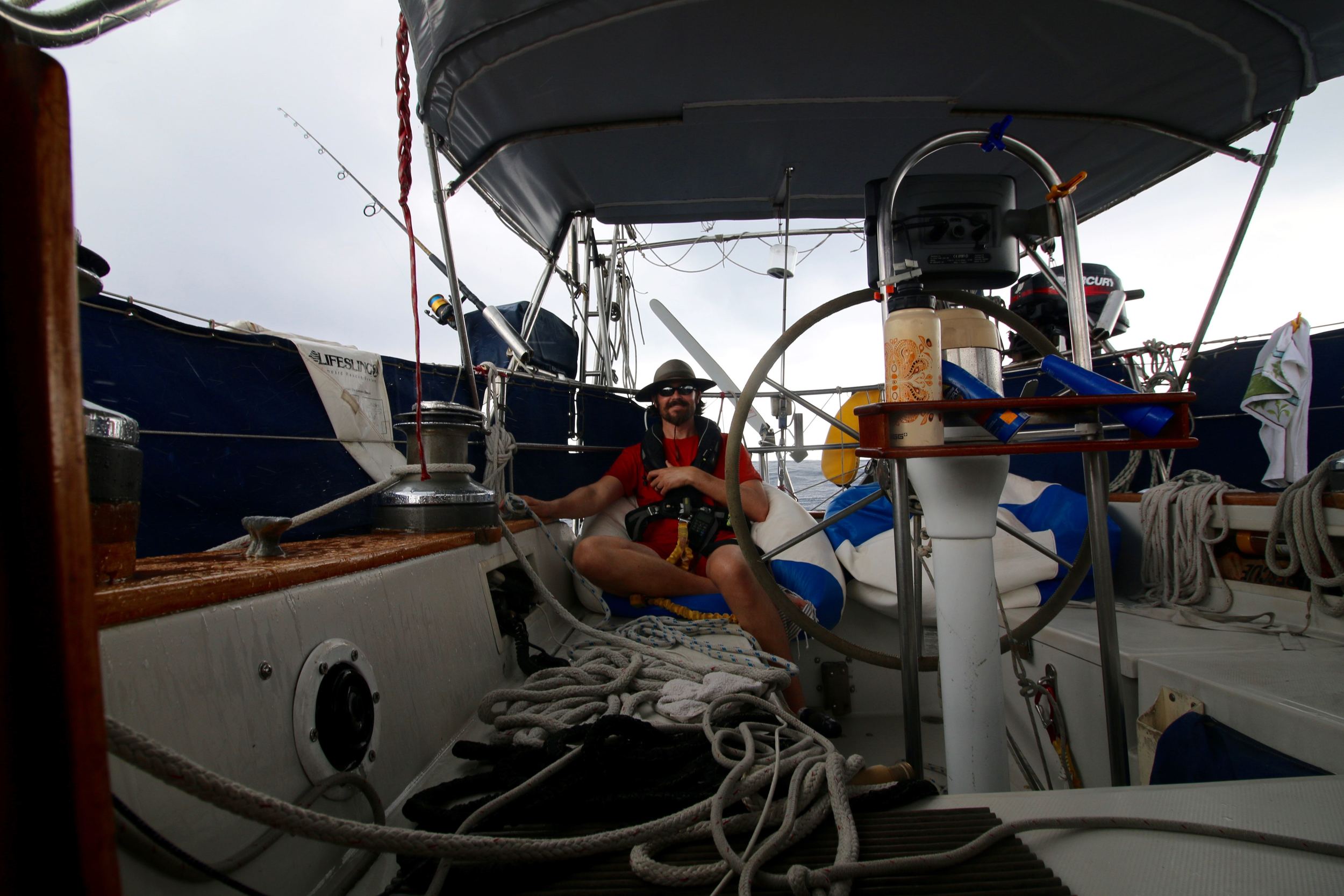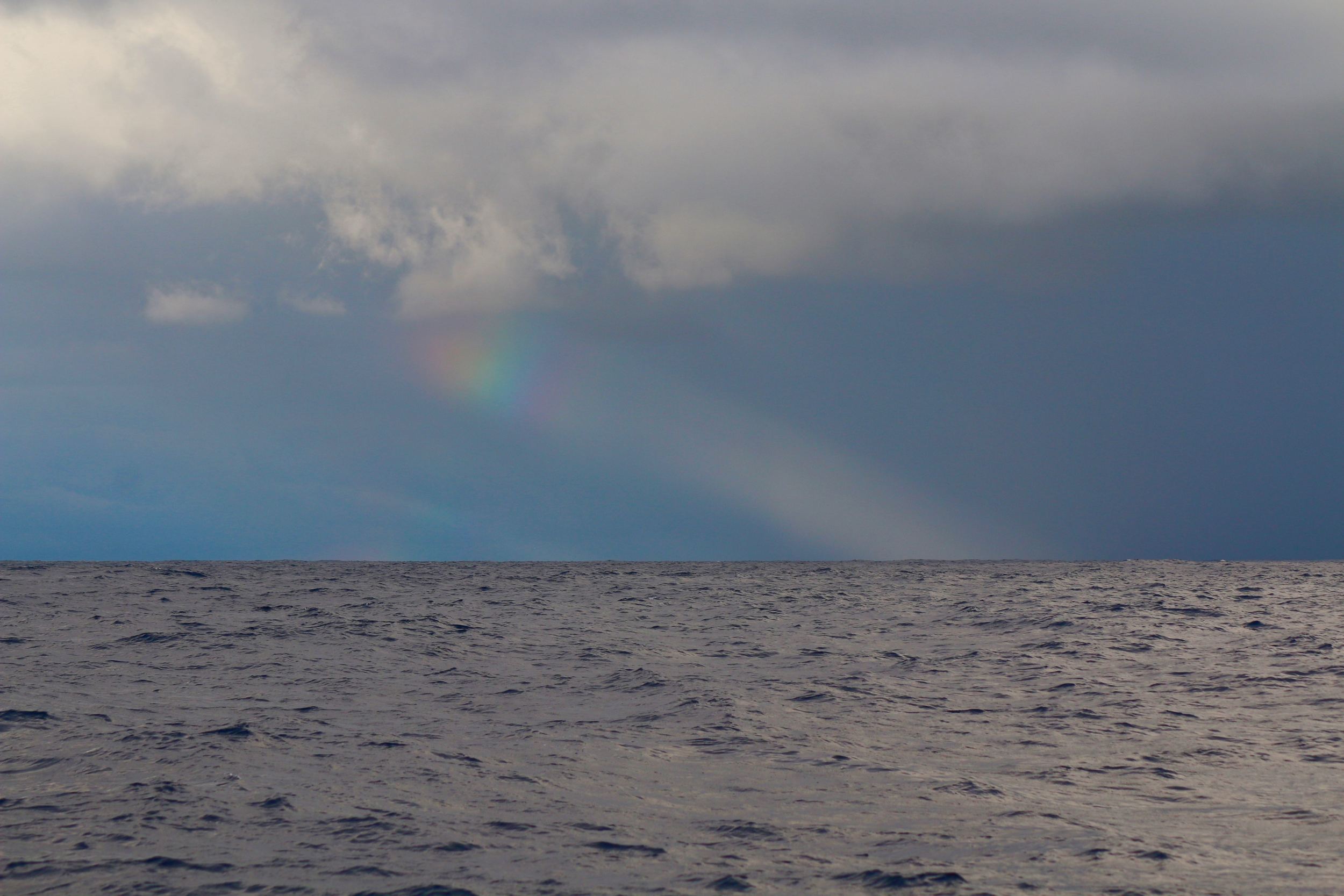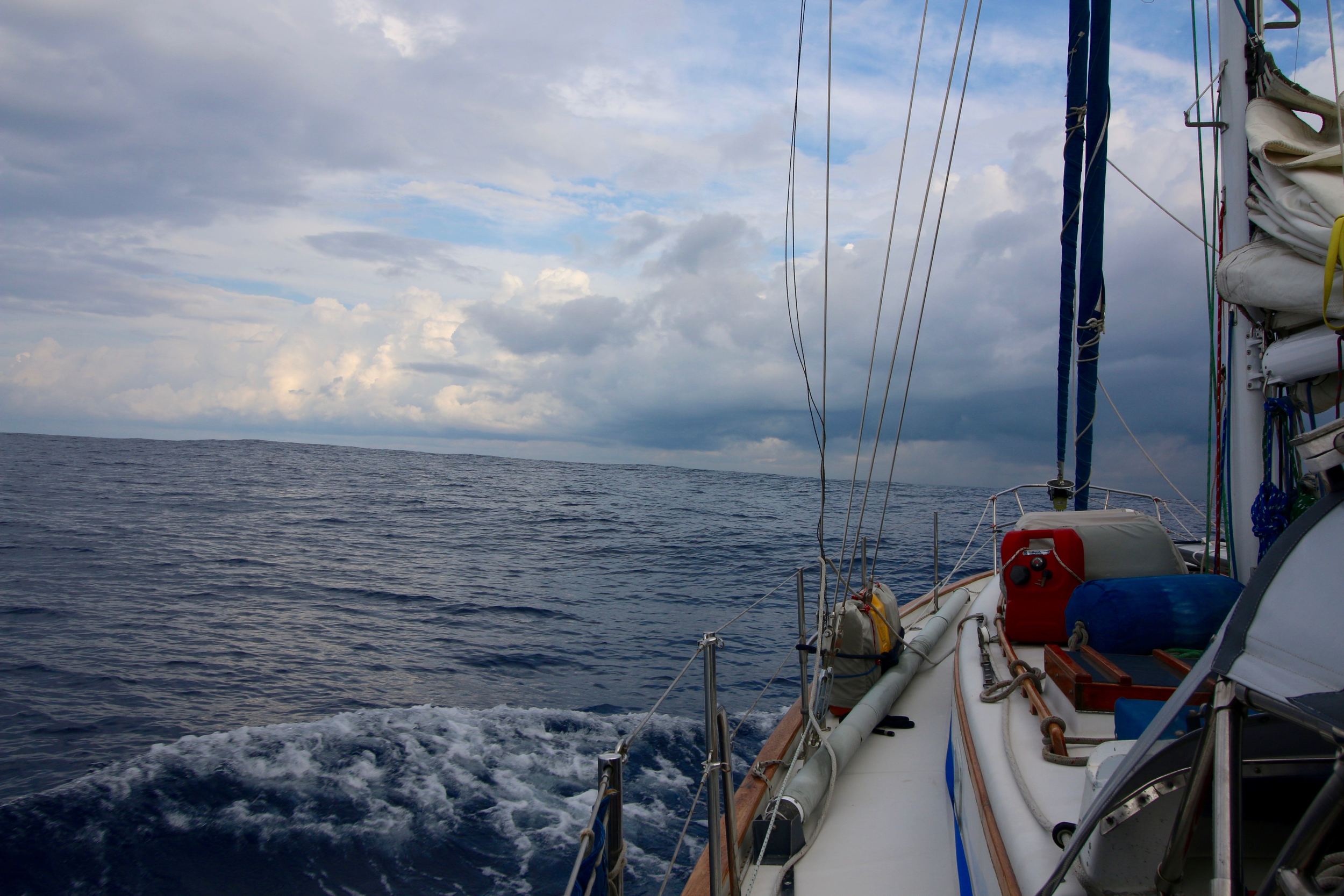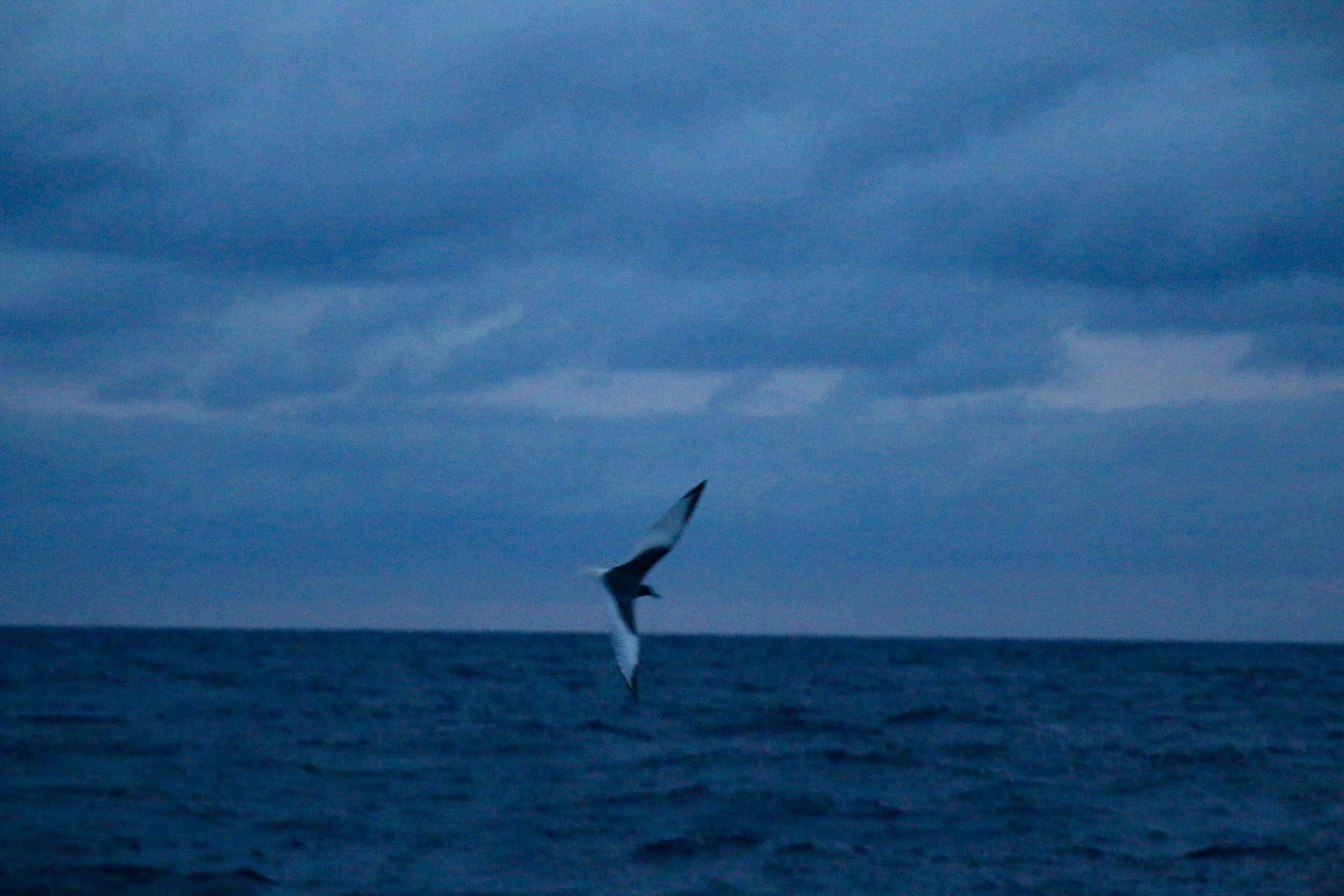“For being in a ship is being in jail, with the chance of being drown.”
By April 11, we reached The Doldrums. The telltale anvil head clouds hung heavy just above Sonrisa’s mast, squalls painted vertical lines of water over a grey horizon, and the wind died completely. While Sonrisa rocked on the peaks and troughs of waves that dance in no particular pattern, she wallowed in place. We fired up the engine and steeled ourselves for a long, buzzing motor southward.
This is where our spirits began to sag. The engine makes the cabin below even hotter than it is with just the tropical sun and humidity. Up above, the constant clatter of the engine makes your teeth chatter. Diesel fumes waft into the cockpit every now and then, roiling our stomachs.
“Just wait until we reach the Southern trade winds, all will be better.” Andrew promised, hope in his voice. We were all looking forward to reaching the Galapagos in just four or five days time, but I was harboring a (mostly) unspoken fear: we were going to have to sail upwind after the Doldrums.
What is so bad about sailing upwind, you ask? Quick sailing lesson: there is only one directly a sailboat cannot go under sail: directly upwind. When you are faced with wind head on, instead of sailing directly into it, you must “tack” meaning you zig-zag upwind (hopefully) 30 degrees off the wind in bite size chunks. Unfortunately, this almost doubles the milage you are required to sail to get to a given point up wind.
As we drift out of the doldrums and start to dry out from the repeated squalls, Andrew’s spirits lift and just like every long hike we have ever done he says: “Just around the corner now!” But, it isn’t. Three days later, four days later, five….and we still weren’t to the equator. As I feared, our heading to reach the Galapagos was 150 degrees i.e. Southeast. And the wind is coming directly from — you guessed it — 150 degrees, Southeast. In addition, a two knot current is pushing from the southeast as well. So every time we try to angle off on the zipper, the current pushes Sonrisa's bow further down, and our angle is almost side to side. Imagine having 360 miles of an 1800 mile trip to go, but instead of making headway you are simply driving side to side on the road in mostly the same place. Any time the wind lightens up, the current drags us further away from our destination. We only have about 100 miles worth of fuel left, so we can’t simply motor our way there.
Our intended route was in blue. Our actual route is in red, further southwest than intended due to some high wind off of Honduras/Nicaragua that blew us down.
We are trapped. Galapagos is the only place we can go. Mainland Ecuador is 600 miles upwind/current Eastward, the Marquesas are 2800 miles West, and home is about 2000 miles North West, with about 1000 of those miles also being upwind. We either get to the Galapagos, or… what? I’ve never been in a situation where I have no options, but here, I have no options. I cannot get off this boat if I want to. My darkest fear is that we cannot make any headway, we fight and fight and fight until eventually bad weather, gear failure (how long will the jib repair hold up?), illness or injury harms us and we have to activate the EPIRB. My first long passage, and I’m not going to make it? Humiliating failure seems close at hand, be that either by failing to reach the Galapagos, or by figuring out how to quit this whole crazy scheme once we get there.
Sonrisa’s crew becomes sullen as this fear takes hold of not just me, but Andrew, too. Andrew begins to worry that we may run...out... of... BEER! Eventually, we speak of it together, wrapping each other up in a hug and trying to confirm that this indeed will not be the case. We will get there, eventually. We have to. There is no other choice.
Our passage now becomes a battle of our will to keep morale high. We throw on Heeling Art’s official race soundtrack - Best Hits of Steve Miller Band or some Jimmy Buffet. I read aloud to Andrew Tony Horowitz’s Blue Latitudes, a book about Captain Cook’s exploration of the South Pacific. We eat well when the wind is not heeling us over like crazy, and we eat ramen noodles when it is. We keep our watch schedule religiously. We sit near each other on deck during the hours we are not on separate watches. Andrew uploads movies on our iPod during our night watches alone. When we check the weather or receive emails from family and friends asking us if we are “there yet” we both fight back the dark fear that grips our throats. I breath to soothe the rawness that impatience leaves in my stomach.
I long for my comfortable bed, stationary kitchen with counter space, fresh vegetables and fruit, a glass of wine, a hike, and a day at the office (oddly enough). I think of one person I love at a time, rolling them around in my mind and savoring the thought, like you would a piece of candy in your mouth.
After all of the preparation we have done, I knew that it would be like this sometimes. I knew it would not be pina coladas and tropical sand all the time. Why, then, am I struggling? In all the reading I have done, people who have circumnavigated say “You will never regret it.” One couple I talked to who had circumnavigated the Pacific said they just “wanted to do it until it wasn’t fun anymore.” They sailed for two full years, and these were two people who set off with very little sailing experience. It makes me feel isolated and weak.
I need to relax, be patient, trust. The wind will shift a little here and there, and we know how to use it. We will go East when the wind is slightly more to the South, and we will go South when the wind is slightly more to the East. We are good sailors. We know what to do, we just have to do it.
And, so that is what we do. From April 13 - 17th, We make only 20 miles per day toward our destination, but cover more than a hundred per day in our zig and zag. Mysterious white and grey birds join us on our journey in the dark of night, clacking and chittering, swooping through Sonrisa’s navigation lights. They never leave our side.
Then just after sunrise during my early morning watch on April 18, the wind dies. With angst, I start the engine to motor toward the Galapagos and prevent the current from dragging us further away. (Use it while we have it, I guess?) But only a half hour later, I feel wind on my left ear. I slow the motor to neutral, and wait. The wind remains steady, so it wasn’t created just by our engine driven momentum. East wind. I pull out all the sails, and gently bring them in tighter and tighter over a few minutes time to slowly gather up all the light air that I can. Soon, the sun is out again and we are pointing Southeast at 170 degrees - closer to our destination heading than we have been in more than a week. As the day develops so does the wind, and we remain heading in the direction of our destination all day.
Our moods lift. My reading of Blue Latitudes has a more hopeful air, and we stop to laugh and talk about how much we want to see a kangaroo in the wild. We can now see other AIS boats in and around the Galapagos. As we close in on the distance we can make with the remaining fuel we have left, I begin to feel hope that we might make it after all.
It is here I realize, once preparations have been made, the only inoculation one can have against deep dread of what might be is a strong faith in one's self and one's ability to handle whatever situation arises. This is no small mental feat.











